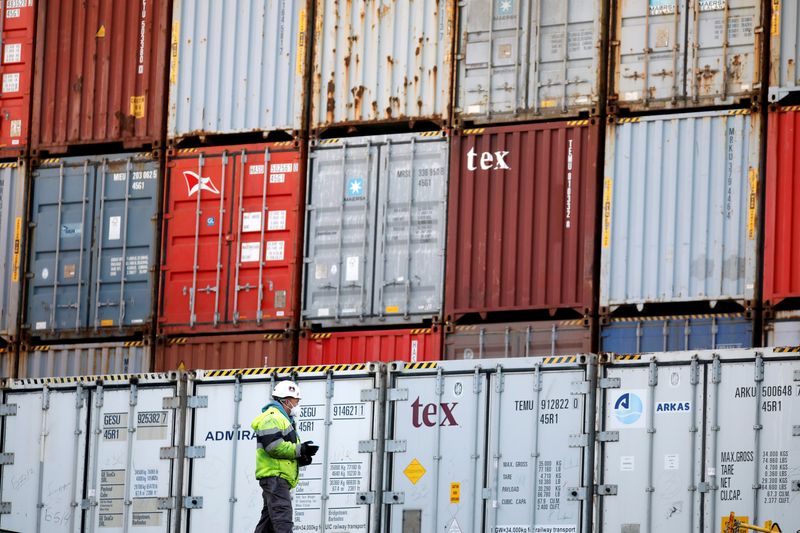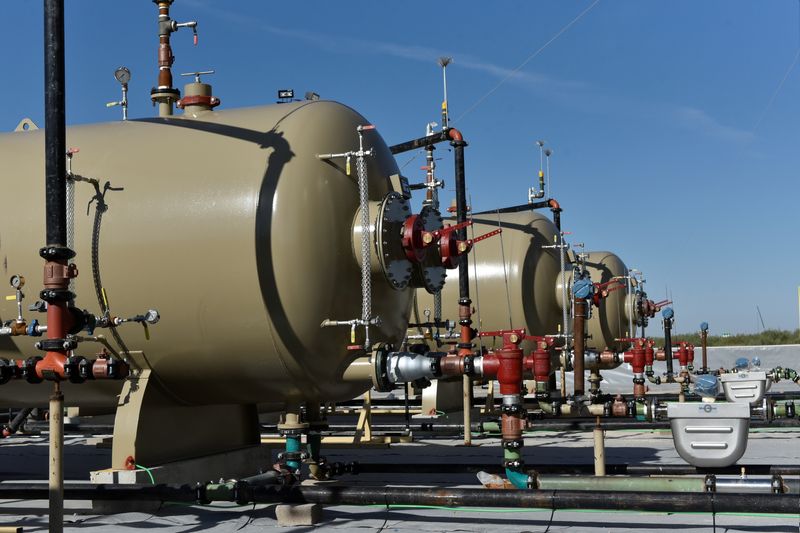Commodities
Energy & precious metals – weekly review and outlook


© Reuters
Investing.com – Two factors will determine the direction of oil markets in the coming week. The first is how much the conflict in the Middle East could escalate and what it might mean for supplies in the world’s top oil producing region. The second is what will the weekly update on US crude stockpiles look like on Wednesday.
Crude prices got to finish the just-ended week up as much as 7%, after somewhat of a roller-coaster. An initial 4% gain on Monday from concerns over the latest Middle East war was pared to just 1% by Thursday from data showing the worst weekly US crude build in eight months, on top of record production.
By Friday, though, it looked like oil had entered a whole new world as the United States exercised its first sanctions against the flouters of the G-7 price cap on Russian oil. As the week drew to a close and crude prices tacked on almost 6% more, the Biden administration had not announced if it will come down hard on Iranian oil next.
There were rumblings though from all fronts, pushing it to act.
One of the chief instigators was Iran itself, which continued to demonstrate the bellicose nature of its relationship with Hamas. State-organized rallies were held across the Islamic Republic Friday in support of the Palestinian terror group, simultaneous with condemnations of the Israeli bombardment of the blockaded Gaza Strip.
In the US Congress, Republicans were just as boisterous. Kevin McCarthy of California said the United States should “stop Iran from being able to produce the oil”. Lindsey Graham of South California said if the conflict escalates, “we should tell the Ayatollah we will destroy your oil refineries and your oil infrastructure.”
Treasury Secretary Janet Yellen did say nothing was ‘off the table’ as the United States considers new sanctions on Iran and Hamas.
The truth is that’s easier said than done.
The crisis in Israel actually poses a new challenge for the world economy and the Biden administration, which has spent the last year working to combat inflation in the United States and to corral energy prices that have become volatile because of Russia’s war in Ukraine. Another war in the Middle East complicates those efforts by threatening to constrain oil supplies and send prices higher.
While “Iran is broadly complicit in these attacks for having supported Hamas going back decades,” there’s currently “no evidence of direct support” for this specific attack, said US Deputy National Security Adviser Jon Finer.
The White House moved instead to close loopholes in its sanctions enforcement on Russia with sanctions on owners of tankers carrying Russian oil priced above the G7’s cap of $60 a barrel.
With Tehran, though, no one could tell what the Biden administration would do.
Since late 2022, Washington has virtually turned a blind eye to surging Iranian oil exports that bypassed US sanctions as it allowed an informal détente with Tehran to get more of the Islamic Republic’s oil onto the world market to offset OPEC+ production cuts. As a result, Iranian crude output is estimated to have surged nearly 700,000 barrels a day this year – the second-largest source of incremental supply in 2023, behind only US shale oil.
Even if the White House advocates a tougher approach on Iranian sanctions, ultimately the amount of oil snagged from the mullahs at midsea might be nominal.
In fact, the administration will likely be more effective in denying Iran some of the cold cash it needs from oil.
Democratic Senator Cory Booker said $6 billion in Iranian oil assets freed up as part of last month’s U.S.-Iran prisoner swap has been re-frozen. The money was meant to be used for food, medicine and other humanitarian goods.
So, money, more than oil, might be at stake on any redoubling of US sanctions’ efforts on Iran.
On the oil inventory front, US crude stocks could see another build in the coming week amid the refinery maintenance season – unless exports, which tumbled the previous week, come back with a huge spike.
In its latest data roundup for the week ended Oct. 6, the US Energy Information Administration, or EIA, said the climbed by 10.176 million barrels, the most since a weekly rise of 16.283M in mid-February.
Crude stocks ballooned last week as exports, often a juggernaut in the weekly EIA report, fell almost 2 million barrels to reach 3.067M per day versus the 4.956M per day level during the week to Sept. 29.
Crude exports hit a record high just shy of 4 million barrels per day in the first half of the year, the EIA said in a separate report on Wednesday.
Processing of crude oil into fuel and other products also dropped last week, by almost 2%, to 85.7% as refineries went into maintenance.
More riveting than that was the EIA’s estimate on crude production. The agency gave that as 13.2M barrels per day – up 300,000 from the prior week. It was the highest ever government estimate on crude production, which prior to this had not exceeded the 13.1M peak reached just before the March 2020 outbreak of the coronavirus pandemic that decimated crude demand.
The EIA has been estimating higher crude production for the United States in recent months, citing higher efficiency in output from US shale oil basins despite a sheer cutback in the number of oil rigs actively deployed by drillers.
“It’s staggering how far US oil production has come in just a few months this year to reach this record high cited by the EIA,” said John Kilduff, partner at New York energy hedge fund Again Capital.
Oil: Market Settlements and Activity
New York-traded , crude for delivery in November did a final trade of $86.35 on Friday after officially settling the session at $87.69, up $4.78, or 5.8%. The US crude benchmark hit a session high of $87.83 versus the week’s low of $82.78.
London-traded crude for the most-active December contract did a final trade of $90.80 on Friday, after officially settling the session at $90.89. The global crude benchmark hit a session high of $91 versus the week’s low of $85.18.
Oil: WTI Technical Price Outlook
The runaway gap for US crude left at $82.80 has been filled with the retracement to $82.30 and fresh to reach $87.80, noted Sunil Kumar Dixit, chief technical strategist at SKCharting.com.
“Going further, immediate resistance in WTI is seen at the Daily Middle Bollinger Band of $88.10 followed by $88.30,” he said.
“Clearing through $88.30 will put $90.80 into focus as the next immediate challenge. If this zone is accepted by market, expect a smooth rally that aims to retest $96.50.”
On the lower end, stability above the 100-week SMA, or Simple Moving Average, of $86.20 may be considered as active support, Dixit said.
“A sustained break below $86.60-$86.20 will be the first indication of sellers gaining confidence looking for a drop to $83 again.”
Gold: Market Settlements and Activity
From near the jaws of $1,700 an ounce, gold bulls are back to $1,900 safety, after the Middle East’s latest crisis led to a huge leap Friday that topped a week of incredible price swings in the yellow metal.
Gold’s most-active contract on New York’s Comex, December, did a final trade of $1,945.90 per ounce on Friday after officially settling the session at $1,941.50, up $58.50, or 3.1%, on the day. For the week, the benchmark gold futures showed a gain of 5%, its most in a week since March.
The , more closely watched by some traders than futures, settled at $1,932.82, up $63.95 or 3.4%. Last Friday, the spot price, which reflects real-time trades in bullion, hit an intraday low of $1,810.10 — less than $10 above $1,700 territory.
Friday’s move up was the biggest in a day for spot gold since March 17. The rounded-up weekly gain of 5% in the current week was also the largest since March.
Gold’s latest jump came after the Israeli government late on Thursday warned more than 1 million people in Northern Gaza to evacuate the area as its war with Hamas escalated. Talk was also growing that Israel was preparing for a major land assault on Gaza.
“Growing chaos in the Middle Easter continues to fuel safe-haven demand for gold as a 2% rally into the weekend also puts pressure on bears in the marketplace,” Neils Christensen wrote on kitco.com, the website of the bullion trading band of the same name.
More startling, the gold rally came as the , or DXY, ticked up for a second day in a row, resuming the greenback’s run-up over the last three months, which was interrupted only by last week’s slide. Gold typically moves in the opposite direction to the dollar.
Gold: Spot Price Technical Outlook
The next immediate resistance for spot gold is seen at the descending trendline point of interest at $1,938 and $1,942, said Dixit of SKCharting.com.
“A continuation above $1,942 will open the door to the previous month high of $1,953, which is the acceleration point for the next bull run into a new record high, after retesting $2,080.”
He also noted that the 4-hour chart on spot gold showed overbought conditions calling for a softening of its momentum, with chances of a pullback towards the breakout zone seen at the 200-day SMA of $1,929 and the 100-day SMA of $1,923.
“If selling pushes the metal below $1,923, expect a further decline to the 50 Day EMA, or Exponential Moving Average, of $1,897, followed by the Daily Middle Bollinger Band of $1,878.”
Natural gas: Market Settlements and Activity
The most-active contract on the New York Mercantile Exchange’s Henry Hub did a final trade of $3.208 per mmBtu, or million metric British thermal units on Friday, after officially settling the session at $3.2360, down 10.8 cents, or 3.2%, on the day. For the week, November gas also fell 2%, versus the prior week’s advance of 14%.
Gas price fell despite the Energy Information Administration, or EIA, reporting a build of just 84 billion cubic feet, or bcf, in storage of the fuel during the week ended Oct. 6, versus the 88 bcf build expected by industry analysts tracked by Investing.com. In the prior week to Sept. 29, storage rose by 86 bcf.
Total gas in US storage was at 3.529 trillion cubic feet as of last week, up 9.8% from a year ago, the EIA said. Earlier this year, the storage was more than 20% up year-on-year. On a five-year basis (2018-2022), inventories were just 4.8% higher, down from double-digits earlier this year.
Natural gas: Price Outlook
Stability below the $3.47-$3.37 level will keep prices in a consolidation mode, looking to retest the support zone of $3.14, followed by the Daily Middle Bollinger Band of $2.97, said SKCharting’s Dixit.
“If this zone fails to hold as support, look for a further drop to the 50-day EMA of $2.84 and the 100-day SMA of $2.66.”
Resumption of the bullish trend will require gas to reclaim momentum above the 50-week EMA of $3.35 and receive firm acceptance as well above the swing high of $3.47, said Dixit.
“The next major resistance sits at the 200-week SMA of $3.77, followed by the 50-month EMA of $3.84.”
Disclaimer: Barani Krishnan does not hold positions in the commodities and securities he writes about.
Commodities
Oil prices rise; U.S. crude inventories plunge, Russia-Ukraine truce eyed
Commodities
India’s Reliance to stop buying Venezuelan oil over US tariffs, sources say
Commodities
Oil prices climb on Venezuela supply worries

 Forex3 years ago
Forex3 years agoForex Today: the dollar is gaining strength amid gloomy sentiment at the start of the Fed’s week

 Forex3 years ago
Forex3 years agoUnbiased review of Pocket Option broker

 Forex3 years ago
Forex3 years agoDollar to pound sterling exchange rate today: Pound plummeted to its lowest since 1985

 Forex3 years ago
Forex3 years agoHow is the Australian dollar doing today?

 Cryptocurrency3 years ago
Cryptocurrency3 years agoWhat happened in the crypto market – current events today

 World3 years ago
World3 years agoWhy are modern video games an art form?

 Commodities3 years ago
Commodities3 years agoCopper continues to fall in price on expectations of lower demand in China

 Economy3 years ago
Economy3 years agoCrude oil tankers double in price due to EU anti-Russian sanctions

























